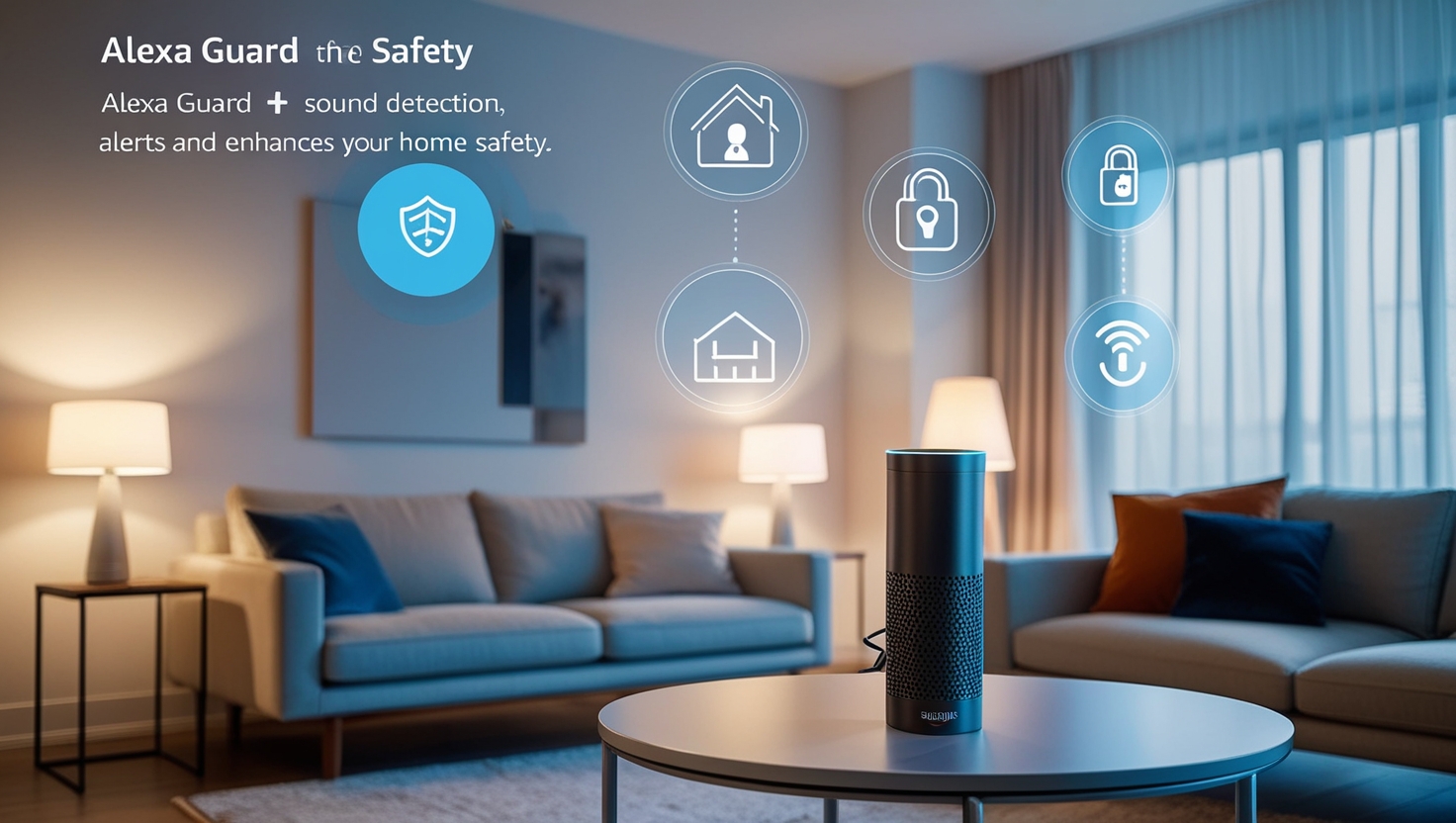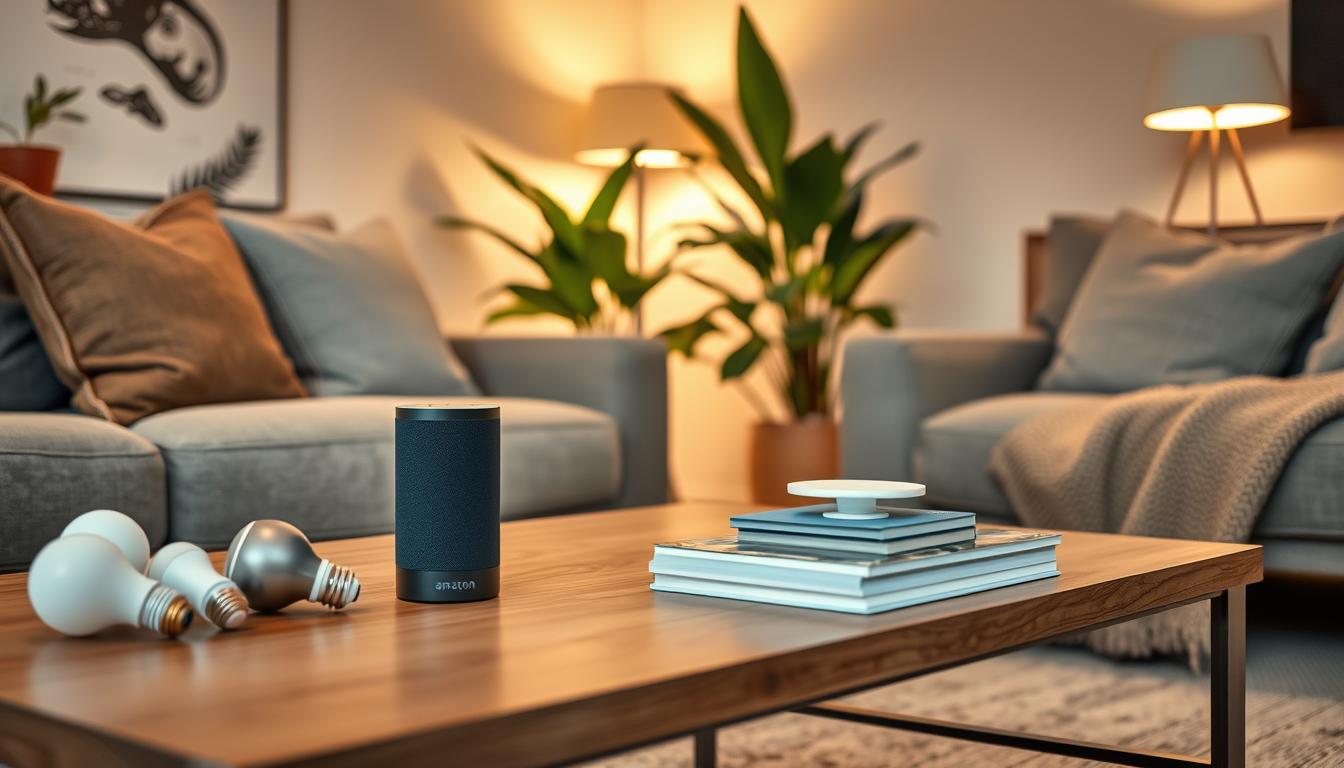Smart homes are now a reality, not just a dream. They use technology to control many things in a house. This includes lights, temperature, security, and entertainment.
In this article, we’ll look at how these homes work. We’ll also talk about their benefits and what the future holds. This technology is changing how we live.
Key Takeaways
- The future of smart home automation is rapidly evolving, with the integration of advanced technologies like artificial intelligence and the Internet of Things (IoT).
- Smart home technology offers improved energy efficiency, enhanced security, and greater convenience for homeowners.
- Connected devices and seamless communication between home automation systems are essential for the success of smart homes.
- The smart home market is experiencing significant growth, with an estimated 785.2 million active households by 2028.
- eSIM technology has revolutionized the smart home industry, providing enhanced connectivity, security, and design flexibility.
Understanding Home Automation Technology
Smart homes use special technology to control things like lights and locks. This tech is made of hardware and software. It lets us manage our homes easily.
The Evolution of Smart Homes
Smart homes started in the 1980s. But, they really changed in recent years. Now, we have voice assistants, advanced sensors, and smart learning.
Key Components of an Automated Home
- Central hub or controller: The brain of the smart home, responsible for coordinating and managing all connected devices.
- Sensors and connectivity devices: A network of sensors and connectivity devices that gather data and enable communication between various components.
- Intelligent appliances: Household appliances, such as lights, thermostats, and security systems, that are designed to work seamlessly with the home automation system.
How Home Automation Systems Communicate
Home automation systems talk to each other using special ways. These include ZigBee, Z-Wave, and Wi-Fi. They make sure devices can work together well.
“The home automation industry has become popular in recent years, with new smart home products continually entering the market.”
The home automation market is getting bigger. It’s expected to be worth $114 billion by 2025. People want smart homes for convenience, safety, and saving money.
The Benefits of Smart Homes
Smart homes make our lives better in many ways. They save energy and money. They also make our homes safer and more convenient.
Energy Efficiency and Cost Savings
Smart homes let us control things with our phones. This can cut energy use by 12-15%. It means lower bills and a greener home.
Smart thermostats are key in saving energy. They help us use less power and save money.
Enhanced Security and Safety
Smart homes have better security. They have cameras, sensors, and smart locks. This makes homes 60% safer than non-smart homes.
These systems also warn us of dangers like smoke. They keep our families safe.
Convenience and Time Savings
Smart homes make our lives easier. We can control them from anywhere. A survey found 89% of users like setting up their day.
This makes our homes 30% more efficient. It’s a big improvement over old homes.
Smart homes are a big win. They save energy, are safer, and are more convenient. No wonder 92% of users are happier than those in old homes.
| Benefit | Statistic |
|---|---|
| Energy Savings | 12-15% reduction in energy consumption |
| Security | 60% fewer break-ins in smart homes |
| Convenience | 89% of users appreciate customizable routines |
| Efficiency | 30% increase in household task management |
| Satisfaction | 92% of users report greater satisfaction |
“Smart homes have shown to improve quality of life, with 92% of smart home users reporting greater satisfaction with their living environment than those living in traditional homes.”
Popular Smart Home Features
Smart homes are becoming more common. They have cool features that make our homes better. These include smart lights, climate control, and security systems.
Smart Lighting
Smart lights change color and brightness with just a voice command. The Roku Smart Bulb SE Color is cheap and has 16 million colors. It works with Alexa and Google Assistant.
Intelligent Climate Control
Systems like the Ecobee Smart Thermostat Premium control your home’s temperature. They save energy and make your home comfy.
Home Security Solutions
Home security systems like the TP-Link Tapo C120 camera keep you safe. They have features like facial recognition. The Ultraloq U-Bolt Pro lets you control your door with your phone.
Home Entertainment Automation
Smart TVs and Roku make watching movies easy. Devices like the TP-Link Kasa Smart Plug control your entertainment. They make your home theater better.
These smart home features change how we live. They work with voice assistants and AI. The smart home market keeps getting better, offering more cool stuff for our homes.
| Product | Rating | MSRP | Current Price |
|---|---|---|---|
| TP-Link Tapo C120 Outdoor Security Camera | 4.5 stars | $39.99 | $24.99 |
| Ezviz DB1C Wi-Fi Video Doorbell | 4.0 stars | $99.99 | $199.99 |
| Ultraloq U-Bolt Pro Wi-Fi Smart Lock | 4.5 stars | $249.00 | $179.99 |
| ADT Command Security System | 4.0 stars | $599.00 | $599.00 |
| Vivint Smart Home | 4.5 stars | N/A | $39.99/month |
| SimpliSafe Home Security System | 4.5 stars | $249.96 | $149.96 (40% off) |
The Future of Home Automation
Technology keeps getting better, and home automation is no exception. Soon, homes will use artificial intelligence (AI) and machine learning. This will make our homes very smart and responsive.
The Internet of Things (IoT) will also change smart homes a lot. More devices and sensors will connect. This will make our homes better at controlling things like lights and security.
Integration with Artificial Intelligence
Home automation and AI will change how we live. Smart homes will learn what we like and need. They will make our lives easier and more fun.
The Role of the Internet of Things (IoT)
More devices will connect, making homes smarter. This will make controlling our homes easier. It will also save energy and make our homes safer.
Home automation is going to change our lives a lot. With AI and IoT, our homes will be smarter and more personal. This will make our daily lives better in many ways.
“The future of home automation lies in the seamless integration of AI and IoT, empowering our living spaces to adapt and cater to our evolving needs and preferences.”
Future of Smart Home Automation
As we look into the future, smart homes will get even smarter. They will use advanced tech like AI and IoT. This will change how we live at home, making it more seamless and smart.
AI will play a big role in smart homes. It will learn what we like and how we live. This means our homes will adjust to fit our needs perfectly. Plus, AI can help things last longer, saving us money on repairs.
The Internet of Things (IoT) will also grow in smart homes. This will make all devices work together smoothly. Soon, we’ll see homes that use VR for a more real experience.
These new techs will make our homes greener and more efficient. They can cut down on energy waste and make our homes safer. This is all thanks to smart home tech.
The future of smart homes is exciting. With AI and IoT, our homes will be more than just places to live. They will be smart, efficient, and tailored to our needs.
“The smart homes of the future will offer homeowners a truly seamless and intelligent living experience.”
Potential Applications of Smart Home Automation
Smart home automation has changed how we live. It lets us control our homes in new ways. This technology is amazing.
Smart Homes and Connected Appliances
Smart home tech lets us control our homes easily. We can manage lights, heat, and more from afar. It makes our lives better and saves energy.
We can control our homes with just a tap or voice command. It’s really convenient.
Connected Cars and Telematics
Smart home tech also changes cars. It brings updates and better car connections. This makes driving safer and more fun.
Our homes and cars will soon work together. This will make our lives easier and more efficient.

“The smart home revolution is not just about convenience; it’s about transforming the way we live, work, and play. By integrating our homes, our appliances, and our vehicles, we’re unlocking a new level of efficiency and connectivity that was unimaginable just a few years ago.”
Smart home tech is getting better all the time. It helps us save energy and stay safe. Our homes will soon fit our needs perfectly.
Enhanced Connectivity and Global Roaming
eSIM (embedded SIM) technology has changed how we connect and roam globally. It lets users switch networks easily without swapping SIM cards. This makes traveling and using different networks simple.
This new tech makes our lives easier. It lets us pick the best service for our needs. We can choose based on cost or coverage. Plus, eSIMs make it easy to keep our phones connected without hassle.
| Feature | Benefit |
|---|---|
| eSIM technology | Eliminates the need for physical SIM cards, enabling seamless switching between mobile network operators |
| Global roaming | Provides uninterrupted connectivity across different countries and regions, enhancing user experience |
| Remote device management | Streamlines the process of maintaining connectivity and reduces the potential for errors or delays |
eSIM technology is now in many devices, like phones and smartwatches. It makes staying connected easy, no matter where you are. This tech is leading to a future where staying in touch is effortless.
“eSIM technology has revolutionized the way we think about global roaming, empowering users with unparalleled connectivity and convenience.”
Improved Security and Authentication
Smart home tech is getting better with eSIM (embedded SIM). It makes homes safer by not needing physical SIM cards. This means less chance of someone messing with your device.
eSIM devices also use strong encryption to keep data safe. This is key when lots of devices talk to each other in smart homes. It keeps your info private and safe.
Being able to update security online is a big plus. It helps fight off new threats fast. This makes your devices more secure against the growing Internet of Things (IoT) in smart homes.
Also, strong data encryption keeps data safe as it moves between devices and the cloud. This protects your info from hackers. It lets you enjoy smart home perks while keeping your data safe.
eSIM tech and remote security updates are key for better security in smart homes. They help build trust and confidence in home automation for the future.
Reduced Physical Size and Design Flexibility
eSIM technology has changed how devices are made. It lets makers make gadgets that are smaller and sleeker. This makes devices look better and work with more smart tech.
Now, devices like phones and home gadgets can have eSIMs. This makes homes smarter and more connected. It lets makers design products that are both cool and work well with smart homes.
| Key Benefit | Impact |
|---|---|
| Reduced eSIM size | Enables more compact, aesthetically pleasing device designs |
| Increased design flexibility | Facilitates the integration of smart technology into a wider range of IoT devices and smart home applications |
| Seamless smart home integration | Promotes the growth of interconnected, intelligent home environments |
eSIM tech is key for smart homes. It lets makers make devices that are small but powerful. This means our homes and gadgets will work together better in the future.

“The flexibility in design enabled by eSIM technology is a game-changer for the smart home industry, empowering manufacturers to create innovative products that seamlessly integrate with the broader connected ecosystem.”
Increased Storage Capacity and Over-the-Air Updates
eSIM technology has made big changes in how we store data and update devices. Now, our devices can hold more data. This is great for smart homes and cars that need to store lots of info.
Also, eSIM lets us update devices without touching them. This keeps our devices safe and working well. No need to mess with them physically.
This is very important in healthcare. Devices like remote monitors and wearables can get updates without us. For example, Whirlpool’s smart ovens get new features and recipes online.
LG ThinQ smart fridges and dishwashers also get updates. These updates make them use less energy and work better.
| Device | Over-the-Air Update Benefits |
|---|---|
| Whirlpool Smart Ovens | New features, cooking methods, and recipes |
| LG ThinQ Refrigerators and Dishwashers | Improved energy efficiency and diagnostic capabilities |
| Samsung SmartThings Ecosystem | Enhanced performance and water usage for appliances |
| Dyson Pure Cool Air Purifiers | Improved air quality readings and fan speed control |
| Tesla Powerwall Energy Storage | Enhanced battery management and efficiency |
As smart homes grow, we’ll see even more improvements. Expect better eSIM storage capacity and remote device updates. These will help our connected car data storage and IoT device updates too.
“Over-the-air updates have become a game-changer, allowing us to continuously enhance the functionality and performance of our smart home devices without the need for manual intervention.”
Enhanced Remote Management and Provisioning
eSIM technology changes how we manage devices from afar. It lets businesses control devices without touching the SIM card. This makes updates and changes fast and easy.
This new way of managing devices makes things better for everyone. It helps businesses work more efficiently and makes customers happier. eSIM makes it easier for IT teams and gives users a smooth experience.
| Key Benefits of eSIM Remote Management | Key Benefits of eSIM Provisioning |
|---|---|
|
|
Using business benefits of eSIM helps companies manage devices better. It makes work more efficient and customer service better. eSIM is changing how businesses handle their devices.
Conclusion
The smart home of the future is here. It offers many new things. Homeowners can save energy, feel safer, and have more fun.
Things like artificial intelligence and the Internet of Things make homes smarter. They also make homes work better together. This is thanks to eSIM technology.
But, we need to think about privacy and safety too. We also need to consider how smart homes change real estate and cities. Finding the right balance is key to making homes better for everyone.
As we look ahead, smart homes will keep getting better. They will learn our habits and talk to other devices easily. Home security, saving energy, and health will all get a boost.
With 5G and AR/VR, the future of smart homes is bright. It’s going to be very exciting to see what’s next.






